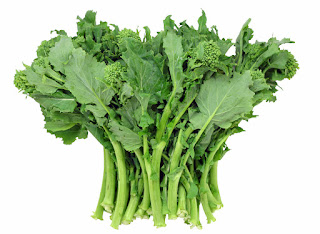Anyway, it all started a few months back. I had wanted to put up a random blog piece, with Internet-supplied photos, about the difference between Broccoli, Broccolini, Chinese Broccoli, and Broccoli Rabe, the four main types of broccoli I worked with through my years in the restaurant industry.
We eat a lot of broccoli in this house, be it blanched, or roasted, or sauteed with other vegetables and meat, or shaved raw into a salad. Good stuff. The name sounds Italian, right?
This version was developed in Italy as it were, so the Italian sounding name fits.
The corporate kitchen gig I had served lots of the next picture, broccolini. When I first started working there I said, "Ooh, broccoli rabe...popular side dish?" thinking it wouldn't be, not in Texas.
They said, "No no, this isn't broccoli rabe, it's broccolini..."
They told me it was a mix between broccoli and kale, but they were only half right. Broccolini is a mix between regular broccoli and Chinese broccoli, also known as kai lan:
We served a ton of kai lan at the first restaurant I worked at in Manhattan. We would blanch it in ocean-salty water and it was great. The greens are more robust than chard but less than kale and the buds resemble broccoli in flavor and look. Chinese broccoli is great.
Next in my memory was one of the reasons I was inspired in the first place last November (or whenever) to start this post idea: broccoli rabe:
It is similar to kai lan in that it's a mix of leaves and broccoli-looking buds, but the leaves are far more dynamic looking, the buds denser, and the color more midnight green and less neon.
And the taste. Holy cow, the flavor. It's, eh, acquired. If done really well, the fiery bitterness is perfectly complemented with salt and garlic and pepper flakes, and it's awesome. If done poorly, it's barely edible.
Those four pictures and the accompanying anecdotes were the basis for this concept---comparing four types of "broccoli"---an idea and plan that languished for months until recently when I started doing some research.
All four plants come from the Brassica genus, one of the two genera of "mustard plants." Oh really?
How interesting...Brassica nupus gives us the rape flower and the rapeseed, of which the world makes and consumed barrels of oil. The Canadian Oil company decided that "rapeseed oil" is not a good name for marketing (or sales) purposes, so they renamed it "canola oil." Brassica rapa gives the very similar rapini plant, otherwise known as raab or rabe, and when the greens are budding, we call it broccoli rabe.
So what? So this: I just wanted to get that part out of the way. Broccoli rabe, radishes, turnips, rutabaga, mustard greens, mustard seed, prepared mustard, and canola oil are all from the same family of plants.
And broccoli...?
This is where my dive down the rabbit hole ended up with me looking at Brassica oleracera as a dude from a lost Pynchon title...
It all started around the fifth century BCE, when humans decided they liked eating the leaves of a plant now called wild cabbage. They selected for plants with the best leaves, using an activity we like to call artificial selection (see the domesticated dog). Pretty soon, these folks had created a cultivar and the culinary kale was introduced to the world.
Thereafter there was a preference selected for the density of the bunched leaves, called the terminal bud, which lead to the cultivar known today as cabbage.
In Germany they selected for thicker stalks and developed kohlrabi (kohl is German for cabbage...). In Belgium they focused on selecting for lateral buds and ended up with Brussels sprouts. In other parts of Europe they focused on the premature buds, which lead them to cauliflower (15 century), and a century later, broccoli.
Do you see all those underlined culinary items: kale, cabbage, cauliflower, broccoli, Brussels and kohlrabi?
THEY ALL COME FROM THE SAME SPECIES.
Add to the list collard greens, romanesco, kai lan, all forms of cabbage, and all forms of kale.
Frankly I wasn't prepared for that result. I thought they were connected, surely, but the exact same specie?
Domestication and selection for specific preferences has led, over the course of less than five thousand years, to a whole slew of vegetables...that many American's revile...
...but this household eats in abundance.
Cruciferous veggies...they're good for you! That's what we tell the boy! And he likes 'em!




No comments:
Post a Comment